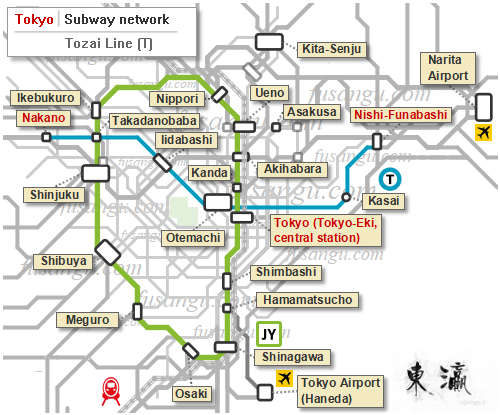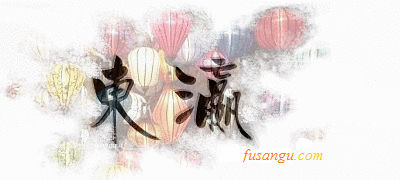
The Tozai-sen is a subway line linking neighbourhoods in Tokyo and Chiba prefectures. The line connects to other railway lines and offers long-distance through services, which can be useful also to visitors.
In this page we describe a one-day tour along the Tozai Line. The article includes a programme suitable for short stays.
The Tozai Line (Tozai-sen) is managed by the main operator, Tokyo Metoro. Through services are available at both ends. Some westbound trains continue their journey on the Chuo-Sobu Line while some eastbound trains end their journey at Toyo-Katsutadai Station. From this station it is possible to reach Katsutadai Station on foot and take a train to Narita Airport.
As suggested by its denomnation, the Tozai line serves an east-west connection. East of the centre of Tokyo, the line runs through peripheral districts such as Edogawa. The line crosses the centre north of Tokyo Station. Areas of interest for visitors are the following:
-
Edogawa, a peripheral district of Tokyo where it is possible to find cheap mid-range hotels. Since the Tozai provides a relatively fast connection between this area and the city centre, particularly Chuo and Chiyoda, choosing to stay in Edogawa is a good option for those who need to keep their budget within stringent limits. A station around which many cheap hotels are found is Kasai Station;
-
Koto, a district located east of Tokyo’s city centre. It is home to a few temples, gardens and historic sites though these are generally visited only by long-term visitors;
-
Nihombashi, a historic neighbourhood of Chuo, central district. Though very little survived the war here, there are still a few sightseeing places. Ginza is adjacent to this area. Furthermore, three major subway line (Asakusa, Hibiya and Ginza lines, which are fundamental routes for any visitor) cross this area;
-
Otemachi, major transfer station (four more lines serve it), very close to Tokyo Station, the city’s central station and shinkansen main terminal;
-
Kudanshita, transfer station, serving Yasukuni-Jinja;
-
Iidabashi, a residential area. A few important shrines and temples are located here. Koishikawa Koraku-En garden lies just across the Kanda River;
-
Kagurazaka, a small alley famous for its shops and restaurants. It is one of the few areas of Tokyo where you can find instances of the traditional architecture, in the form of tea houses and elegant residences. Some of Tokyo’s most illustrious restaurants specialising in Japanese haute cuisine are located in this area;
-
Takadanobaba, a neighbourhood of Shinjuku, just north of the main station. Interchange with the Yamanote Line (Tokyo's railway loop line);
-
Nakano, a must-see places for those who are into Japan’s contemporary popular culture.
Recommended itinerary along the Tozai Line
Below is the outline of a programme that suits well the needs of a first-time visitor. We assume you start your journey in Edogawa, a neighbourhood where you can easily find convenient accommodation options:
-
Edogawa (Tokyo Subway Museum): 1 hour;
-
Nihombashi and Ginza (walking tour through the city centre): 2 hour;
-
Kudanshita, Iidabashi and Bunkyo (Yasukuni-Jinja, Sotobori Park, Koishikawa Koraku-En): 3 hours;
-
Nakano (Nakano Broadway shopping arcade, a favourite of manga, anime, cosplay, collectionism buffs): 2-3 hours.
Variants
You can add a few more destinations, especially if you do not mind including some walking tours:
- Kagurazaka: you can choose to explore Kagurazaka as well as the area around Waseda University, a popular hang-out spot for students brimming with cheap eateries;
- National Museum of Modern Art, which is very close to Takebashi Station.
Related articles:
Main article: Tokyo 3-day itinerary
Itineraries along the subway lines (Asakusa, Hibiya, Ginza, Marunouchi, Tozai, Mita, Namboku, Yurakucho, Chiyoda, Shinjuku, Hanzomon, Oedo, Fukutoshin)

